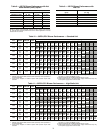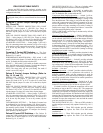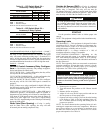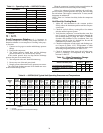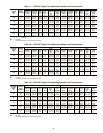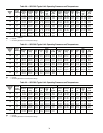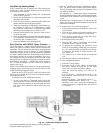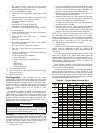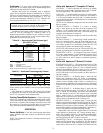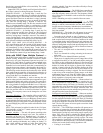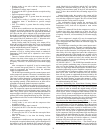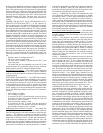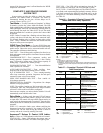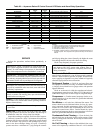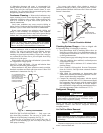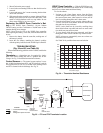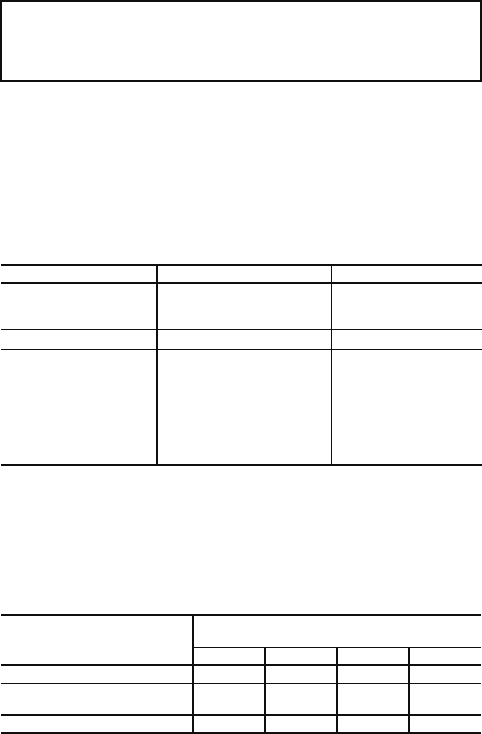
33
Antifreeze — In areas where entering loop temperatures
drop below 40 F or where piping will be routed through areas
subject to freezing, antifreeze is needed.
Alcohols and glycols are commonly used as antifreeze
agents. Freeze protection should be maintained to 15 F below
the lowest expected entering loop temperature. For example, if
the lowest expected entering loop temperature is 30 F, the
leaving loop temperature would be 22 to 25 F. Therefore, the
freeze protection should be at 15 F (30 F – 15 F = 15 F).
Calculate the total volume of fluid in the piping system. See
Table 24. Use the percentage by volume in Table 25 to
determine the amount of antifreeze to use. Antifreeze concen-
tration should be checked from a well mixed sample using a
hydrometer to measure specific gravity.
Table 24 — Approximate Fluid Volume (gal.)
per 100 Ft of Pipe
LEGEND
NOTE: Volume of heat exchanger is approximately 1.0 gallon.
Table 25 — Antifreeze Percentages by Volume
FREEZE PROTECTION SELECTION — The 30 F FP1
factory setting (water) should be used to avoid freeze damage
to the unit.
Once antifreeze is selected, the JW3 jumper (FP1) should
be clipped on the control to select the low temperature (anti-
freeze 13 F) set point to avoid nuisance faults.
Cooling Tower/Boiler Systems — These systems typ-
ically use a common loop temperature maintained at 60 to 90 F.
Carrier recommends using a closed circuit evaporative cooling
tower with a secondary heat exchanger between the tower and
the water loop. If an open type cooling tower is used continu-
ously, chemical treatment and filtering will be necessary.
OPERATION
Power Up Mode —
The unit will not operate until all the
inputs, terminals and safety controls are checked for normal
operation.
NOTE: The compressor will have a 5-minute anti-short cycle
upon power up.
Units with Aquazone™ Complete C Control
STANDBY — Y and W terminals are not active in standby
mode, however the O and G terminals may be active, depend-
ing on the application. The compressor will be off.
COOLING — Y and O terminals are active in Cooling mode.
After power up, the first call to the compressor will initiate a
5 to 80 second random start delay and a 5-minute anti-short
cycle protection time delay. After both delays are complete, the
compressor is energized.
NOTE: On all subsequent compressor calls the random start
delay is omitted.
HEATING STAGE 1 — Terminal Y is active in heating
stage 1. After power up, the first call to the compressor will
initiate a 5 to 80 second random start delay and a 5-minute
anti-short cycle protection time delay. After both delays are
complete, the compressor is energized.
NOTE: On all subsequent compressor calls the random start
delay is omitted.
HEATING STAGE 2 — To enter Stage 2 mode, terminal W is
active (Y is already active). Also, the G terminal must be ac-
tive or the W terminal is disregarded. The compressor relay
will remain on and EH1 is immediately turned on. EH2 will
turn on after 10 minutes of continual stage 2 demand.
NOTE: EH2 will not turn on (or if on, will turn off) if FP1 tem-
perature is greater than 45 F and FP2 is greater than 110 F.
EMERGENCY HEAT — In emergency heat mode, terminal
W is active while terminal Y is not. Terminal G must be active
or the W terminal is disregarded. EH1 is immediately turned
on. EH2 will turn on after 5 minutes of continual emergency
heat demand.
Units with Aquazone™ Deluxe D Control
STANDBY/FAN ONLY — The compressor will be off. The
Fan Enable, Fan Speed, and reversing valve (RV) relays will be
on if inputs are present. If there is a Fan 1 demand, the Fan
Enable will immediately turn on. If there is a Fan 2 demand,
the Fan Enable and Fan Speed will immediately turn on.
NOTE: DIP switch 5 on S1 does not have an effect upon Fan 1
and Fan 2 outputs.
HEATING STAGE 1 — In Heating Stage 1 mode, the Fan
Enable and Compressor relays are turned on immediately.
Once the demand is removed, the relays are turned off and the
control reverts to Standby mode. If there is a master/slave or
dual compressor application, all compressor relays and related
functions will operate per their associated DIP switch 2 setting
on S1.
HEATING STAGE 2 — In Heating Stage 2 mode, the Fan
Enable and Compressor relays are remain on. The Fan Speed
relay is turned on immediately and turned off immediately
once the demand is removed. The control reverts to Heating
Stage 1 mode. If there is a master/slave or dual compressor
application, all compressor relays and related functions will op-
erate per their associated DIP switch 2 setting on S1.
HEATING STAGE 3 — In Heating Stage 3 mode, the Fan
Enable, Fan Speed and Compressor relays remain on. The EH1
output is turned on immediately. With continuing Heat Stage 3
demand, EH2 will turn on after 10 minutes. EH1 and EH2 are
turned off immediately when the Heating Stage 3 demand is re-
moved. The control reverts to Heating Stage 2 mode.
Output EH2 will be off if FP1 is greater than 45 F AND FP2
(when shorted) is greater than 110 F during Heating Stage 3
mode. This condition will have a 30-second recognition time.
Also, during Heating Stage 3 mode, EH1, EH2, Fan Enable,
and Fan Speed will be ON if G input is not active.
EMERGENCY HEAT — In Emergency Heat mode, the Fan
Enable and Fan Speed relays are turned on. The EH1 output is
turned on immediately. With continuing Emergency Heat de-
mand, EH2 will turn on after 5 minutes. Fan Enable and Fan
IMPORTANT: All alcohols should be pre-mixed and
pumped from a reservoir outside of the building or
introduced under water level to prevent fuming.
PIPE DIAMETER (in.) VOLUME (gal.)
Copper 14.1
1.25 6.4
1.5 9.2
Rubber Hose 13.9
Polyethylene
3
/
4
IPS SDR11 2.8
1 IPS SDR11 4.5
1
1
/
4
IPS SDR11 8.0
1
/
2
IPS SDR11 10.9
2 IPS SDR11 18.0
1
1
/
4
IPS SCH40 8.3
1
1
/
2
IPS SCH40 10.9
2 IPS SCH40 17.0
IPS — Internal Pipe Size
SCH — Schedule
SDR — Standard Dimensional Ratio
ANTIFREEZE
MINIMUM TEMPERATURE FOR FREEZE
PROTECTION (F)
10 15 20 25
Methanol (%) 25 21 16 10
100% USP Food Grade
Propylene Glycol (%)
38 30 22 15
Ethanol (%) 29 25 20 14



